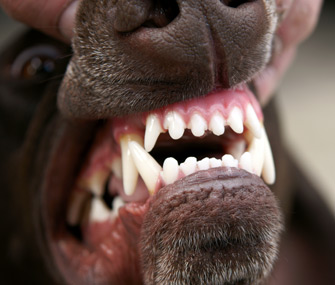Scared About Anesthesia? Don’t Let Your Fears Make You Put Off Dental Care for Your Pets
Published on July 14, 2011
Skip To

Advanced periodontal disease not only makes eating a painful experience for the pet, but it also stresses internal organs with a constant shower of bacteria. As with humans, such advanced dental disease can shorten lifespan and decrease the quality of life.
The Fears
“I’m afraid my pet will die on the table,” an owner says. “I’m too afraid to put him under.”When I hear that, I know I have my work cut out for me. But though anesthesia (or any medical procedure, really) has risks, it has never been safer or more comfortable.
How Anesthesia Works
The simplest definition of anesthesia is putting an animal into an unconscious state so the pet will be immobile and pain free during a procedure.Though many pet lovers think of veterinary anesthesia as a gas given through a mask over the animal’s face, in fact the modern practice of preparing an animal for surgery is a no-size-fits-all combination of injectable medications (often combining anesthesia and pain-control agents), anesthesia-inducing gas, and pure oxygen, the latter two delivered through a breathing tube to maintain an animal’s unconscious state.
Why Prescreening Tests Are Critical
Preanesthetic screening is important: a physical examination and bloodwork can identify underlying problems that need to be addressed. In a young pet, the bloodwork could be just checking for anemia and basic indicators of organ health. In an older pet, it may mean a complete blood count, thyroid screen, checking kidney and liver values and making sure all organs are functioning properly. A senior pet is more likely to have problems than a 6-month-old.Roles and Responsibilities
Your veterinarian does her part to make anesthesia safer and so should you. Prior to surgery, follow your vet’s directions to the letter: no food after midnight means absolutely no food. It’s a matter of safety.During surgery, there will be constant anesthetic monitoring by machines and trained technicians, as well as the use of intravenous fluids during anesthesia to allow the veterinarian to react rapidly if need be. Animals are kept warm, since shivering increases oxygen consumption.
What Dental Care Means for You and Your Pet
With safety measures in place, anesthetic risk is minimized to the extent that the benefits of dental care more than outweigh the concerns, no matter the age of your pet. If you’ve been putting off your pet’s dental care because of your fears, consider how much happier your pet will be after the fiery pain in his mouth has been extinguished.Other benefits of keeping your pet’s mouth healthy:
No more bad breath. The awful smell that comes from the mouths of many pets isn’t normal, no matter how many jokes about “doggy breath” or “tuna breath” you may have heard. After a dental cleaning you will find that your pet has kissable breath again, and it will last if you follow-up with regular care in the form of dental chews, rinses, or regular brushing.
No more fussy eating. The mouths of some older pets are so painful that the pets have a hard time eating. Once bad teeth are removed and attendant problems treated, eating becomes a joy again.
An increased lifespan. Chronic, advanced periodontal disease shortens a pet’s life by stressing the organs and immune system. The chronic suffering also reduces the quality of life for the years a pet does have.
So don’t waste another day worrying about anesthesia while your pet suffers. Your veterinarian is ready to help, with both the care your pet needs and the answers you do.

